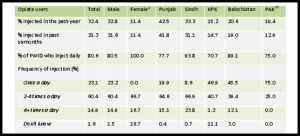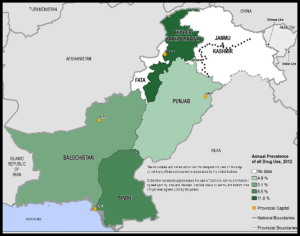By Niala Mohammad and Wagma Jalawan
According to a recent UNDOC survey conducted in Pakistan, 5.8% or 6.45 million people of the population in Pakistan between the ages of 15 and 64 use drugs. The thought of a third world country and its people entrenched in war, terrorism and poverty almost justifies these staggering statistics however Muhammad Shahid, the Director General of Narcotics Control Division of Pakistan told VOA Deewa that 70% of the population uses drugs for “fun seeking” and “peer pressure”, an issue that seems more akin to first world problems.
Naswar to Needles
The most prevalent drug use occurs within Khyber Pukhtunkhwa Province, which was the highest compared to other provinces within Pakistan. An estimated 11% per cent of the population in Khyber Pukhtunkhwa uses illicit substances. An astounding 70.7% percent of Khyber Pukhtunkhwa’s population injects drugs daily.
Khyber Pukhtunkhwa is more commonly known for its use of natural or plant based substances like naswar (snuff), charas (cannabis) and opium. The derogatory image of a Pashtun male rolling a piece of the green textured snuff under his lip is common visual depicted in Pakistani media. In fact Pashtuns and Khyber Pukhtunkhwa have become synonymous with terms naswar and Taliban.
However UNODC’s recent survey, suggests that the population of Khyber Pukhtunkhwa is shifting towards the use of more lethal, synthetic drugs. The most commonly used drugs in Khyber-Pukhtunkhwa are cannabis, opioid, tranquilizers and sedatives. The survey shows that 30,000 men and women use amphetamine-type stimulants (or ATS), a synthetic drug created by processing chemical ingredients. These drugs are available in powder, capsule and liquid forms, some popularly known ATS drugs include Ecstasy and Speed.
Women and Drugs
Many would not assume the sight of a Pashtun female using drugs, even the thought bends the norms of traditional cultural conservatism. Surprisingly, drug use amongst women in Khyber Pukhtunkhwa is becoming more common. Shaukat Ullah Khan, a National Research Officer for the UNODC in Pakistan told VOA Deewa that there are 45,000 women in Khyber Pukhtunkhwa who are addicted to one or more drugs. The reasons for the increase in drug use amongst women in Khyber Pukhtunkhwa are unknown but many psychologists believe stress and anxiety to be a major correlating factor.
Conversely, other research on substance abuse among females in Pakistan suggests drug use as a form of social recreation. Muhammad Shahid, who is spearheading this research, suggests that drug use in women is becoming more prevalent amongst college and university students as a form of “fun”. He also submits that the association to existing drug users and easy access to substance seem to facilitate drug use amongst females in Pakistan. Muhammad Shahid stated, “the majority of female drug users have fathers, brothers or husbands who are addicts”.
A Regional Dilemma
Muhammad Shahid, told VOA Deewa that 74% of the world’s opium is produced in Afghanistan and 40% of that is routed through Pakistan via Khyber Pukhtunkhwa and Baluchistan and supplied to the rest of the world. Khyber Pukhtunkhwa’s proximity to drug trade has made access to illicit substances comparably easier than other provinces.
Drugs and HIV
The survey sheds light on the HIV epidemic in Pakistan. HIV is an issue that Pakistan can no longer ignore, according to a report issued by the Joint United Nations Program on HIV/AIDS, Pakistan is said to have an estimated 98,000 people living with HIV. Out of this estimate 51% were said to have contracted the disease from injecting drugs. Dr Fazle Maula, the Project Director HIV/Aids Control Program, Peshawar told VOA Deewa that there are 1,700 reported cases of HIV/AIDs in Khyber Pukhtunkhwa.
Many cases go unreported because of societal shame due to lack of awareness. People in the region perceive HIV/AIDS to be a “dirty” disease associated with West and sexual promiscuity, a theory especially popular amongst conservative circles whose source often stems from religious extremists.
Contributions Hameed Ullah, Syed Mudassir Shah





